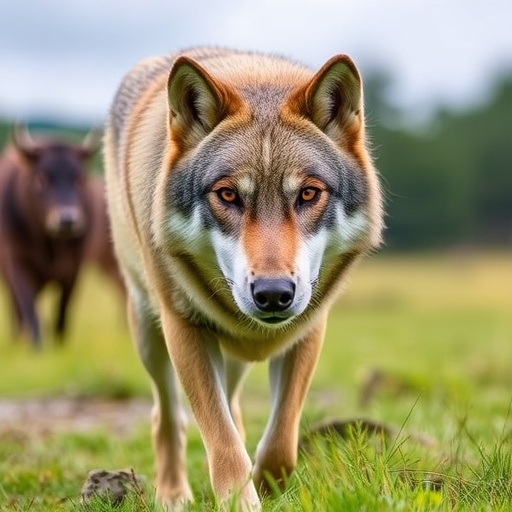Wolves, once extinct in many Central European regions, have made a notable resurgence thanks to stringent conservation laws implemented over recent decades. Their return, while a triumph for biodiversity, presents a complex and evolving challenge for livestock farmers across these areas. The presence of wolves introduces significant predation risks to domesticated animals like sheep, goats, and cattle, compelling agricultural communities to seek effective methods for safeguarding their herds while coexisting with these apex predators.
A collaborative international research initiative involving scholars from the University of Göttingen, Humboldt-Universität zu Berlin, Dresden University of Technology in Germany, and KORA in Switzerland has shed light on livestock farmers’ perceptions of coexistence strategies. Central to this investigation was understanding how farmers regard protective interventions such as the deployment of wolf-repelling electric fences and guard dogs, alongside examining the influence of governmental subsidies on their adoption rates. The findings, published in the esteemed journal People and Nature, illuminate key social and behavioral dynamics underpinning the acceptance of these non-lethal management tools.
The study employed an extensive online survey conducted in 2022 with 353 farmers operating grazing enterprises in Bavaria, one of Germany’s federal states where wolves have re-established territories. Responses were evaluated through the lens of the Theory of Planned Behaviour (TPB), a psychological framework positing that a person’s behavioral intentions are predominantly shaped by three determinants: the individual’s attitude towards the behavior (i.e., perceived usefulness and appropriateness), perceived social pressures from peers and community, and perceived control or capability to enact the behavior. This multifaceted analysis allowed for a nuanced understanding of motivational factors influencing farmers’ decisions regarding wolf conflict mitigation.
Results unequivocally highlighted social pressure as the paramount influence shaping farmers’ willingness to install protective measures. This social dimension underscores the critical role of knowledge exchange and peer demonstration of successful coexistence practices. According to Dr. Friederike Riesch of Göttingen University’s Institute of Grassland Science, fostering networks among livestock owners that facilitate the sharing of experiences can significantly enhance community acceptance and implementation of wolf deterrence solutions. These interactions serve not only to bolster confidence but also to normalize protective strategies culturally and practically within rural societies.
Financial incentives emerged as effective catalysts, but their impact varies across different types of protective measures. Bavaria has established subsidized programs specifically promoting electric fencing designed to repel wolves, complemented by support for employing guardian dogs. Analysis indicated that farmers residing within designated wolf territories demonstrated heightened inclination to adopt these subsidized electric fences. This willingness is partly attributable to regulatory frameworks that condition compensation for wolf-caused damages on evidence of protective infrastructure, which incentivizes compliance and proactive defense strategies.
Interestingly, while subsidies encouraged the uptake of electric fencing, they did not correspondingly affect intentions to use guardian dogs for herd protection. This discrepancy suggests that factors beyond monetary support influence the acceptance of canine guardianship, potentially relating to challenges such as dog management demands, training complexities, or cultural attitudes towards integrating dogs into traditional farming practices. The researchers caution that addressing these issues requires tailored approaches extending beyond financial mechanisms.
Beyond economic motivations and social dynamics, perceived behavioral control—the confidence in farmers’ ability to implement measures effectively—remains a crucial component for successful adoption. The study recommends augmenting subsidy schemes with concrete practical assistance, such as technical guidance in fence installation or training for guard dog handling. This hands-on support can alleviate labor and knowledge barriers, making protective strategies more accessible and sustainable for farmers, especially amid the diverse and often resource-limited contexts of livestock agriculture.
The importance of collaborative platforms emerges strongly from the research, with cross-stakeholder dialogue acting as a vital conduit for reconciling differing perspectives on wolf conservation and livestock management. By enabling farmers, conservationists, policymakers, and scientists to exchange views in constructive settings, tensions surrounding wolves’ return can be diffused, and joint pathways towards harmonious coexistence forged. Such integrative approaches acknowledge the multidimensional nature of human-wildlife interactions and strengthen the social fabric underpinning rural economies.
Financial and institutional support for this study came from the German government’s Special Purpose Fund, managed by Landwirtschaftliche Rentenbank—Germany’s developmental agency focused on agriculture and rural areas—alongside funding from the Federal Ministry of Research, Technology and Space via the GreenGrass project. These cooperative funding structures exemplify the intersection of scientific inquiry, policy development, and practical application essential for addressing emerging conservation challenges in agricultural landscapes.
The research underscores a pivotal message: species conservation success must be matched by socially attuned management strategies that respect and empower local stakeholders. As wolves continue their recolonization into Central Europe’s pastures and woodlands, fostering adaptive, community-rooted protection methods will be crucial. Balancing biodiversity objectives with the economic realities of farmers requires ongoing innovation, inclusive governance, and empathy towards the manifold values vested in pastoral livelihoods.
In summary, the comprehensive survey-driven examination reveals that while economic incentives facilitate the implementation of technical barriers such as electric fences, social acceptance and perceived capability significantly drive the broader integration of coexistence measures. Encouraging peer learning, extending financial support, providing practical resources, and promoting dialogue collectively form the cornerstone of resilient strategies to harmonize pastoral grazing with the ecological resurgence of wolves.
Subject of Research: Not applicable
Article Title: How to reconcile pasture grazing and wolf recolonisation? Perceptions of management options by livestock farmers in Germany
News Publication Date: 24-Sep-2025
Web References:
https://besjournals.onlinelibrary.wiley.com/doi/full/10.1002/pan3.70141
References:
Riesch, F., et al. (2025). How to reconcile pasture grazing and wolf recolonisation? Perceptions of management options by livestock farmers in Germany. People and Nature. DOI: 10.1002/pan3.70141
Image Credits:
Friederike Riesch
Keywords:
Wildlife management, Applied ecology, Game preserves, Agriculture, Conventional farming, Environmental issues, Sustainable agriculture, Farming, Cattle, Livestock, Carnivores, Predators




